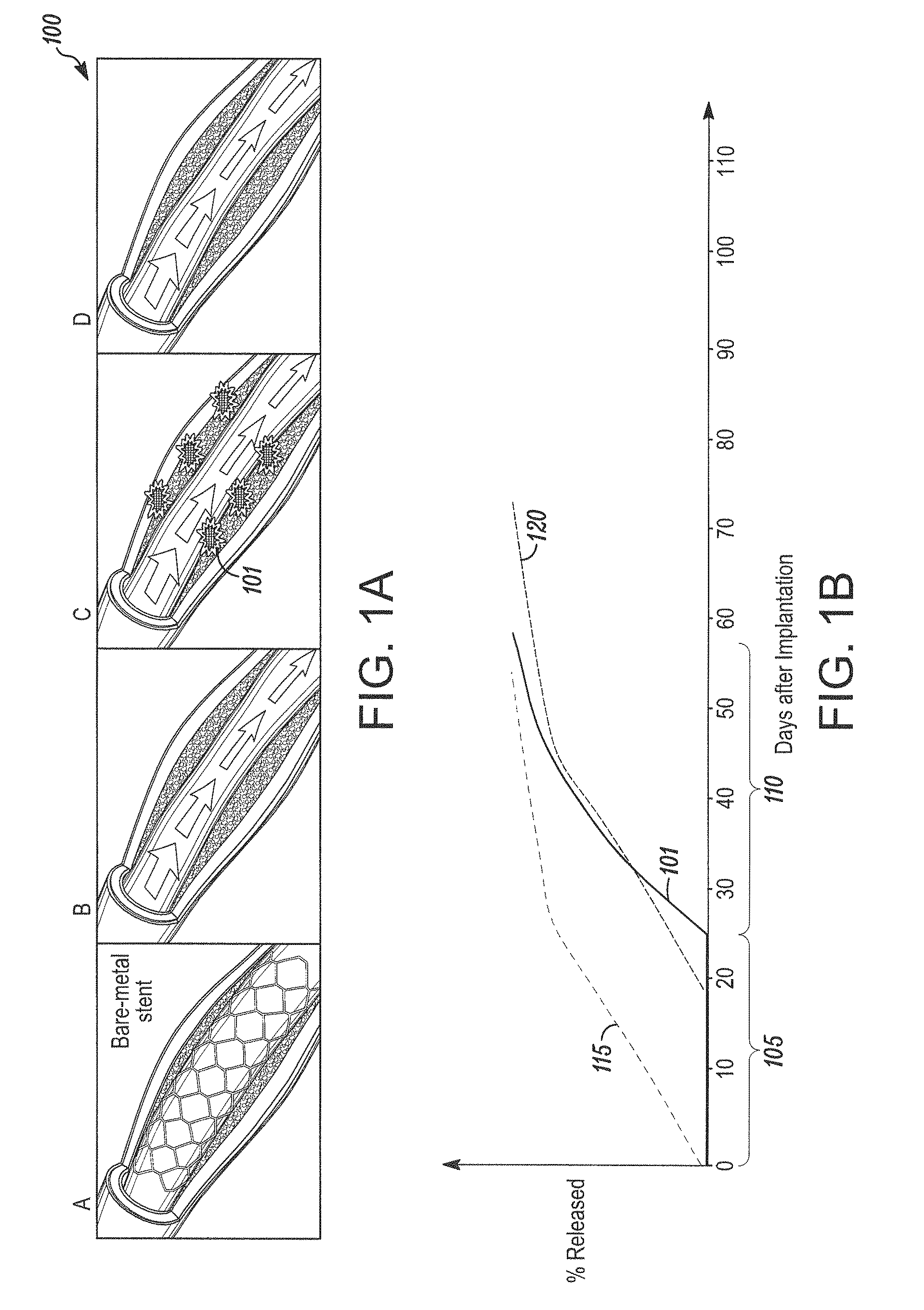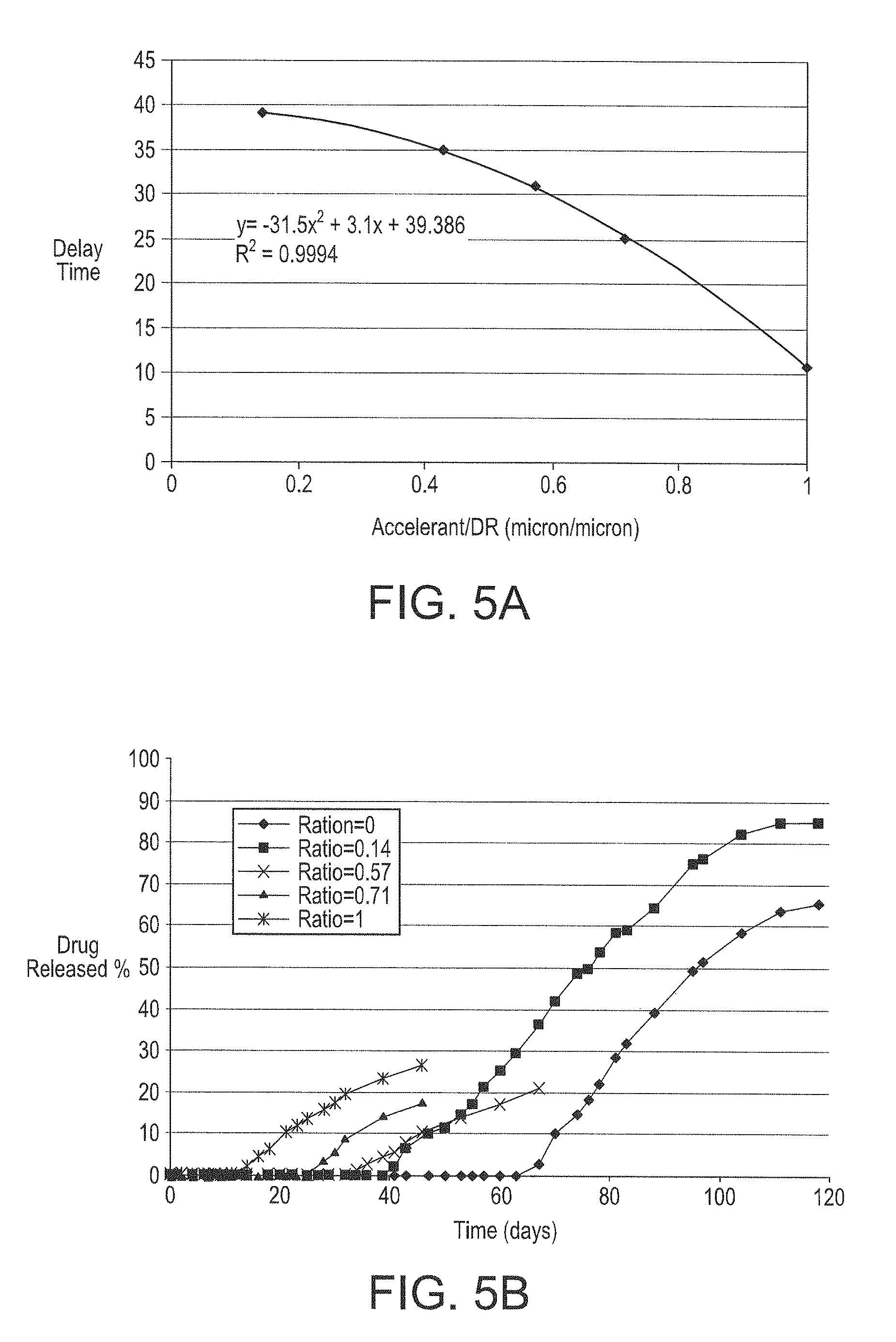Coating system and method for drug elution management
a coating system and drug elution technology, applied in the field of medical devices, can solve the problems of harmful physiological effects, dosage and timing curve, unwanted biological responses, etc., and achieve the effect of promoting drug retention and inhibiting mobilization
- Summary
- Abstract
- Description
- Claims
- Application Information
AI Technical Summary
Benefits of technology
Problems solved by technology
Method used
Image
Examples
example 1
Creating a First Therapeutic Coating Having a Programmed Delayed Time Before the Onset of Drug Release
[0147]This example teaches one way to create a therapeutic coating on a medical device, where the coating has a drug-containing layer, a drug-retaining layer, and an accelerant layer, and the coating provides a programmed delayed time before the onset of drug release.
[0148]The Design
[0149]The drug-containing layer has 81% (w / w) rapamycin in 75:25 PLGA, a MW of 100 KDaltons, is carboxylic acid terminated, 1 micron thickness. The accelerant layer has pure 75:25 PLGA, 100 KDaltons, carboxylic acid terminated, 5 micron; and,
Drug Retaining Layer: Pure 75:25 PLGA, 120 KDaltons, ester (methoxy) terminated, and 2 micron thickness
[0150]The Manufacturing Method
[0151]Rapamycin and poly(lactic-co-glycolic acid) (PLGA) are weighed in an 81% mass Rapamycin and 19% mass PLGA, and dissolved in acetone to yield a 1% mass per volume drug coating solution. The specific PLGA used is 75% lactide and 25%...
example 2
Creating a Second Therapeutic Coating Having a Programmed Delayed Time Before the Onset of Drug Release
[0163]This example teaches one way to create a therapeutic coating on a medical device, where the coating has a drug-containing layer, a drug-retaining layer, and an accelerant layer, and the coating provides a programmed release of a drug.
[0164]The Design
[0165]The drug-containing layer has 20% (w / w) rapamycin in 75:25 PLGA, a MW of 140 KDaltons, is carboxylic acid terminated, 6 microns thick. The accelerant layer has pure 75:25 PLGA, 100 KDaltons, carboxylic acid terminated, 6 microns thick; and,
Drug Retaining Layer: Pure 75:25 PLGA, 120 KDaltons, ester (methoxy) terminated, 12 microns thick.
[0166]The Manufacturing Method
[0167]Rapamycin and poly(lactic-co-glycolic acid) (PLGA) are weighed in an 20% mass Rapamycin and 80% mass PLGA, and dissolved in acetone to yield a 1% mass per volume drug coating solution. The specific PLGA used is 75% lactide and 25% glycolide, has ester end gr...
example 3
A Programmed Coating can be Designed to Allow for a Particular Delay in Initial Release of a Drug and a Particular Release Rate
[0175]This example shows that a delay time in an initial release of a drug can be programmed by coating design and can vary independent of the elution rate of the drug. By varying the coating composition within the parameters taught herein, for example, the coating of Example 1 was designed and produced to have a delay time of 26 days for an initial release of the drug from the drug-retaining layer.
[0176]Elution Medium
[0177]Preparing a 2% w / w Tween 20 solution in phosphate buffered saline solution:
[0178]Materials: Polysorbate 20 (Tween 20); phosphate buffered tablets; distilled water; gravimetric balance having a sensitivity to 4 or 5 decimal places; stir bar; stir plate; glass beaker; flask or a plastic container; disposable polyethylene transfer pipet; graduated measuring container.
[0179]Procedure
[0180]The glass or plastic container is placed on the balanc...
PUM
| Property | Measurement | Unit |
|---|---|---|
| thickness | aaaaa | aaaaa |
| time | aaaaa | aaaaa |
| time | aaaaa | aaaaa |
Abstract
Description
Claims
Application Information
 Login to View More
Login to View More - R&D
- Intellectual Property
- Life Sciences
- Materials
- Tech Scout
- Unparalleled Data Quality
- Higher Quality Content
- 60% Fewer Hallucinations
Browse by: Latest US Patents, China's latest patents, Technical Efficacy Thesaurus, Application Domain, Technology Topic, Popular Technical Reports.
© 2025 PatSnap. All rights reserved.Legal|Privacy policy|Modern Slavery Act Transparency Statement|Sitemap|About US| Contact US: help@patsnap.com



